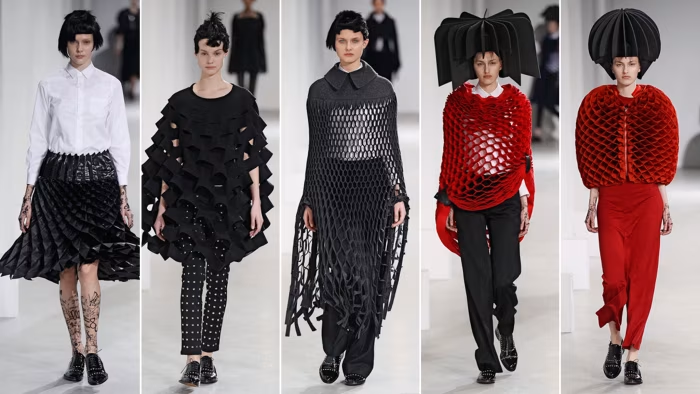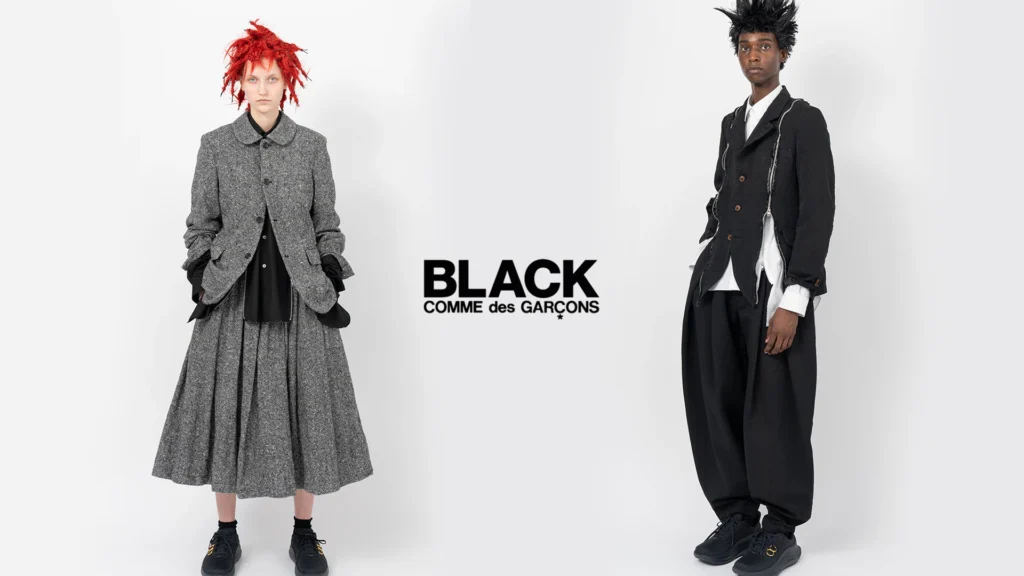Introduction: The Beginning of a Fashion Revolution
At the beginning of the 1970s, Tokyo experienced the emergence of a designer who would completely change the world of fashion in the international context: Rei Kawakubo, the founder of Comme des Garcons. Comme des Garcons came out of a fast-modernizing post-war society in Japan as a revolt against the traditional beauty, gender roles, and the ideal of beauty in the West.
Since its small and modest origins in Tokyo, up to its presence today as an avant-garde fashion empire, Comme des Garcons is not merely a brand but is more like a philosophy of creative liberty and rebellion. This paper discusses the way in which Rei Kawakubo, in her childhood and Tokyo in the 1970s, influenced one of the most radical and powerful fashion brands in the world.
Tokyo in the 1970s: The Perfect Storm for Change
A City in Transformation
The 1970s were a period of cultural and economic revolution in Tokyo. The reconstruction and modernization had taken decades to completely redefine Japan. Western consumerism was spreading rapidly, the department stores were flourishing, and the youth were becoming more expressive in terms of art, music, and fashion.
But in this new prosperity, there was also unrest – a yearning to get out of conformity. The youth in Tokyo needed individuality, experimentation, and breaking the monotony. It is in this electric atmosphere that Rei Kawakubo started her radical path.
The Rise of a New Fashion Scene
The new designers in Tokyo started questioning the superiority of Western fashion ideas. They did not want to copy Parisian glamour, but rather to make something purely Japanese, universal, and recognizable.
Comme des Garçons, founded in 1969 by Kawakubo, was one of the participants of this movement. The initial collections of the label could be characterized by monochrome colorations, asymmetrical cuts, and the idea of imperfection – an idea based on wabi-sabi, the Japanese philosophy of imperfection and transience.
Rei Kawakubo: The Reluctant Designer
From Philosophy to Fashion
Rei Kawakubo did not receive fashion training. She was born in Tokyo in 1942 and received her education in the fine arts and aesthetics at Keio University in Tokyo, which is one of the most distinguished institutions in Japan. She was employed in Asahi Kasei, a textile firm, after graduation, and here she got to know about the construction of fabrics and the study of material science- this experience would later determine her way of designing.
Her move into the fashion world was slow. During her employment as a stylist for women’s magazines, she started designing her clothes in frustration as she could not find a single outfit that would resemble her outlook.
Later, in 1969, she founded Comme des Garçons, translated as like boys in French, which was a reference to her gender-neutral philosophy and anti-establishment ethos.
Breaking Gender Boundaries
Since the start, Rei Kawakubo has not subscribed to conventions of femininity. Her designs crossed the boundary between genders – oversized models, coarse fabrics, and the austerity of shape undermined beauty itself.
The work by Kawakubo was unashamedly crude in a society that upheld feminine appeals of prettiness and polish. This was not merely fashion but a revolution of philosophy, of self-questioning what clothing and female beauty ought to be.
Comme des Garcons: The Early Years in Tokyo
The First Collections
By the early 1970s, Comme des Garcons had begun making an impression in the Tokyo creative circles. These collections were frequently colorless, mainly black, gray, and white, and contained deconstructed clothes that appeared incomplete, tattered, or uneven.
The aesthetic of Kawakubo was not luxurious but intellectual and emotional. At one point, she said that something to be beautiful doesn’t necessarily have to be pretty.
These initial collections came to be associated with the counterculture spirit in Tokyo and were very popular among intellectuals, artists, and youths who wanted authenticity.
Establishing Comme des Garcons Co., Ltd
Comme des Garçons Co., Ltd. was officially established in Tokyo in 1973 by Rei Kawakubo. The brand soon acquired a cult following among the young people in Japan who claimed it as a type of cultural insurrection.
Comme des Garcons glorified androgyny and flaw at a time when Western fashion was focused on glamour and the body-consciousness of its figures. The clothes did not concern style; they were ideas.
Aesthetic of Rebellion: The Philosophy Behind the Brand
Wabi-Sabi and the Beauty of Imperfection
The Comme des Garcons aesthetic was strongly inspired by Japanese cultural philosophy, particularly the notion of wabi-sabi, which is the beauty of imperfection and ephemeral nature.
The designs by Kawakubo were full of deliberate irregularities, uncovered seams, and asymmetries that reject the traditional methods of construction. Thus, she converted weaknesses into art forms.
Clothing as Conceptual Art
Instead of considering fashion as an ornament, Kawakubo looked at it as conceptual art. Each of the collections was an intellectual experiment – a criticism of the fashion system.
This strategy re-established the affiliation between designer and audience. Comme des Garcon did not produce to satisfy; instead, it challenged the audience to think and interpret, requiring them to challenge their personal assumptions about beauty, gender, and identity.
Genderless and Timeless
Comme des Garcons themselves were born timeless by not serving to meet gender-specific and seasonal fashion demands. The unisex shapes, neutral colors, and sculptural lines of the label were symbolic of having no classification and were radical in the 1970s, and this would later form the basis of the whole genderless fashion movement.
The Cultural Impact in Japan
Tokyo’s Fashion Underground
The boutiques of Comme des Garcons in Tokyo (1970s) were the centres of the avant-garde. The brand gained the interest of artists, intellectuals, and rebels who fought against mass consumerism.
This was an underground movement that saw Tokyo rise to become a fashion capital across the world, where ideas were as important as trends. Kawakubo and his peers, such as Issey Miyake and Yohji Yamamoto, were the new generation of creativity and independence in Japan.
Changing the Perception of Fashion
Towards the close of the ten-year decade, Comme des Garcons had transformed itself into a brand of creative rebellion, where it was once a localized niche brand. Not only fashion, but it profoundly affected the rest of Japanese culture, including the image of the country that could innovate intellectually and experiment with aesthetics.
Preparing for Paris: The Next Chapter Begins
From Tokyo to the World
Towards the end of the 1970s, Rei Kawakubo had gained cult status in Japan. Her fans not only envied her designs but also admired her non-compromise. However, Kawakubo had the desire to expand beyond Japan to realize her concepts.
However, in 1981 she unveiled Comme des Garcons in Paris, which would shatter the fashion scene – but which had been readied deeply in Tokyo of the 1970s.
The Legacy of the 1970s Era
Rei Kawakubo described her creative DNA from her Tokyo years. They taught her to doubt, to ruin, and to make. The ethos of reinvention and the spirit of resistance in the Japanese post-war became the pillars of the world influence of Comme des Garcons.
Homeless Tokyo, 1970s, with its contradictions, its energy, and a desire to change, could never have existed without Comme des Garcons as we know it today.
Rei Kawakubo’s Lasting Influence
Beyond Fashion Design
Rei Kawakubo has a presence in the fashion world, as well as art, architecture, and cultural theory. Generations of designers have been inspired by her philosophy, which states that clothes should arouse emotion and thought.
To this day, Kawakubo still has no problem with the boundaries between fashion and philosophy, and her collections are not comfortable, but challenging. Through Comme des Garcons, Dover Street Market, and several sub-labels, her work shows the nonconformist nature of her work.
A Continuing Revolution
Fifty years later, the zeitgeist of Tokyo of the 1970s still beats through each collection of Comme des Garcons. In Paris, New York, or Tokyo, the brand is still a representation of radical thinking, creative insubordination, and avant-garde.
What started as a minor label in Tokyo has turned into a worldwide movement, which agrees that the ability to be creative means having the heart to challenge everything.
Conclusion: The Radical Child of Tokyo
The Comme des Garcons that was born with the Tokyo of the 1970s was not only a fashion phenomenon but also an awakening of cultural enlightenment. The aspiration of Rei Kawakubo to produce something completely original changed not only Japanese fashion but the whole innovative world.
Non-conformity, her imperfection, her non-fearing experimentation made Comme des Garcons the ultimate symbol of intellectual rebellion.
According to Rei Kawakubo herself:
“Creation is not about beauty. It is associated with creating something new.”
From the small streets of Tokyo to the largest runways in the entire world, Comme des Garcons is and will be the living reminder that fashion at its finest is a radical action, and that it all started with a single designer in 1970s Tokyo.













